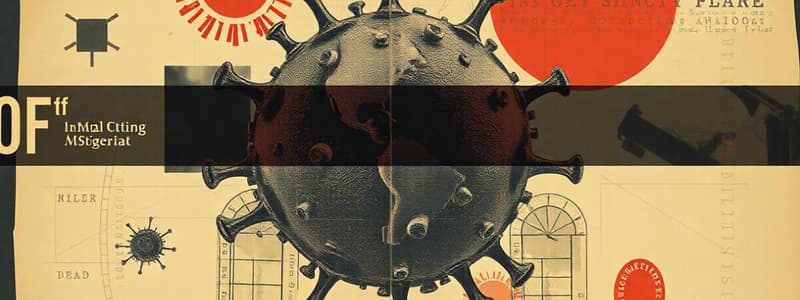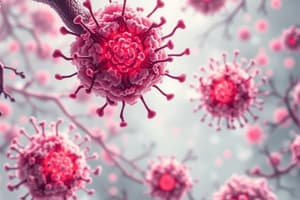Podcast
Questions and Answers
What is the main mediator responsible for Type I hypersensitivity reactions?
What is the main mediator responsible for Type I hypersensitivity reactions?
- IgE (correct)
- IgG
- T cells
- IgM
Which type of hypersensitivity is characterized by a delayed onset of symptoms?
Which type of hypersensitivity is characterized by a delayed onset of symptoms?
- Type II
- Type III
- Type IV (correct)
- Type I
In hemolytic anemia (Type II hypersensitivity), which immunoglobulin is primarily involved in the destruction of cells?
In hemolytic anemia (Type II hypersensitivity), which immunoglobulin is primarily involved in the destruction of cells?
- IgE
- IgD
- IgA
- IgM (correct)
What treatment is commonly used for immediate hypersensitivity reactions like anaphylaxis?
What treatment is commonly used for immediate hypersensitivity reactions like anaphylaxis?
Which class of hypersensitivity involves the formation of immune complexes that deposit in tissues?
Which class of hypersensitivity involves the formation of immune complexes that deposit in tissues?
Which symptom is NOT typically associated with Type IV hypersensitivity reactions?
Which symptom is NOT typically associated with Type IV hypersensitivity reactions?
Which cytokine is primarily responsible for driving IgE production in Type I hypersensitivity?
Which cytokine is primarily responsible for driving IgE production in Type I hypersensitivity?
Which of the following statements about the complement system is true?
Which of the following statements about the complement system is true?
Which type of hypersensitivity is commonly treated with topical steroids?
Which type of hypersensitivity is commonly treated with topical steroids?
Which of the following symptoms is commonly associated with serum sickness (Type III hypersensitivity)?
Which of the following symptoms is commonly associated with serum sickness (Type III hypersensitivity)?
Which type of hypersensitivity is immediate and often involves IgE antibodies?
Which type of hypersensitivity is immediate and often involves IgE antibodies?
What are the primary mediators released in Type I hypersensitivity reactions?
What are the primary mediators released in Type I hypersensitivity reactions?
Which symptoms are associated with serum sickness (Type III hypersensitivity)?
Which symptoms are associated with serum sickness (Type III hypersensitivity)?
In Type II hypersensitivity, how do IgG and IgM contribute to cell destruction?
In Type II hypersensitivity, how do IgG and IgM contribute to cell destruction?
Which cytokine is known to enhance inflammation in Types II and III hypersensitivity?
Which cytokine is known to enhance inflammation in Types II and III hypersensitivity?
What treatment is commonly prescribed for Type IV hypersensitivity reactions?
What treatment is commonly prescribed for Type IV hypersensitivity reactions?
What is the main trigger for contact dermatitis (Type IV hypersensitivity)?
What is the main trigger for contact dermatitis (Type IV hypersensitivity)?
Which type of hypersensitivity results from the deposition of immune complexes in tissues?
Which type of hypersensitivity results from the deposition of immune complexes in tissues?
Which symptom is NOT typically found in anaphylaxis (Type I hypersensitivity)?
Which symptom is NOT typically found in anaphylaxis (Type I hypersensitivity)?
In Type IV hypersensitivity, which immune cells are primarily involved?
In Type IV hypersensitivity, which immune cells are primarily involved?
What is the time frame for symptom onset in Type IV hypersensitivity reactions?
What is the time frame for symptom onset in Type IV hypersensitivity reactions?
Flashcards
Hypersensitivity
Hypersensitivity
An exaggerated or inappropriate immune response to an antigen.
Type I Hypersensitivity (Immediate)
Type I Hypersensitivity (Immediate)
A rapid, IgE-mediated reaction that occurs within seconds to minutes of exposure to an allergen. Examples include anaphylaxis and asthma.
Type II Hypersensitivity (Cytotoxic)
Type II Hypersensitivity (Cytotoxic)
An antibody-mediated reaction where IgG or IgM bind to cell surface antigens. This results in cell destruction. Examples include hemolytic anemia and Rh incompatibility.
Type III Hypersensitivity (Immune Complex-Mediated)
Type III Hypersensitivity (Immune Complex-Mediated)
Signup and view all the flashcards
Type IV Hypersensitivity (Delayed-Type)
Type IV Hypersensitivity (Delayed-Type)
Signup and view all the flashcards
Anaphylaxis
Anaphylaxis
Signup and view all the flashcards
Hemolytic Anemia
Hemolytic Anemia
Signup and view all the flashcards
Serum Sickness
Serum Sickness
Signup and view all the flashcards
Contact Dermatitis
Contact Dermatitis
Signup and view all the flashcards
Complement System
Complement System
Signup and view all the flashcards
Study Notes
Hypersensitivity Overview
- Hypersensitivity is an exaggerated or inappropriate immune response to antigens.
- Four types exist: Type I, Type II, Type III, and Type IV.
Type I Hypersensitivity
- Mechanism: IgE-mediated, fast onset (seconds to minutes).
- Mediators: Mast cells and basophils release histamine, leukotrienes, and prostaglandins.
- Examples: Anaphylaxis, asthma.
Type II Hypersensitivity
- Mechanism: IgG or IgM antibodies bind to cell surface antigens, activating complement or phagocytosis.
- Examples: Hemolytic anemia, Rh incompatibility.
- Mediators: IgG, IgM, complement
Type III Hypersensitivity
- Mechanism: Antigen-antibody complexes deposit in tissues, causing inflammation.
- Triggers: Foreign proteins or drugs.
- Examples: Serum sickness, Post-Streptococcal Glomerulonephritis (PSGN).
- Mediators: Antigen-antibody complexes, complement.
Type IV Hypersensitivity
- Mechanism: T-cell-mediated, delayed onset (48-72 hours).
- Examples: Contact dermatitis, tuberculin skin test.
- Mediators: T cells release cytokines, activating macrophages.
Clinical Manifestations
-
Anaphylaxis (Type I): Symptoms include hypotension, airway constriction, and urticaria (hives). Mediators include histamine and leukotrienes. Treatment involves epinephrine, antihistamines, and corticosteroids.
-
Hemolytic Anemia (Type II): Symptoms include fatigue, jaundice, pallor, and dark urine. Mediators involve IgG, IgM, and complement. Examples include Rh incompatibility and blood transfusion reactions
-
Serum Sickness (Type III): Symptoms are fever, rash, joint pain, and swollen lymph nodes. A trigger is often foreign proteins/drugs.
-
Contact Dermatitis (Type IV): Characterized by a red, itchy, and vesicular rash. Common triggers include allergens like poison ivy or nickel. Treatment usually involves avoiding the allergen & topical steroids.
Immune Mediators and Mechanisms
- Type I: IgE triggers mast cells/basophils releasing histamine, leukotrienes, and prostaglandins.
- Type II: IgG/IgM activates complement or phagocytosis
- Type III: Immune complexes activate complement and recruit neutrophils
- Type IV: T cells release cytokines, activating macrophages
Key Concepts for Differentiation
- Mediators: Antibodies (Types I-III), T cells (Type IV).
- Onset: Immediate (Type I) to delayed (Type IV).
- Treatment: Antihistamines (Type I), Steroids (all types), Immunosuppressants (Type IV), Biologics (target specific mediators).
Cytokines and Complements
-
Cytokines:
- IL-4 drives IgE production (Type I).
- TNF-α enhances inflammation (Types II, III).
- IFN-γ activates macrophages (Type IV).
-
Complement System: Cascade of proteins that identifies and destroys pathogens; crucial in Types II and III.
Test Tips
- Memorize the immune mediators for each type (e.g., IgE for Type I, IgG/IgM for Types II & III, T cells for Type IV).
- Understand the examples and symptoms of each hypersensitivity type.
- Be familiar with the time of onset and specific triggers for each hypersensitivity type.
- Know the therapeutic interventions and their rationale.
Studying That Suits You
Use AI to generate personalized quizzes and flashcards to suit your learning preferences.




